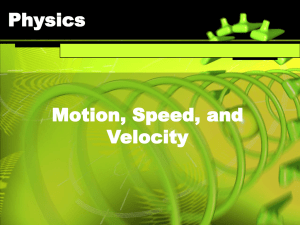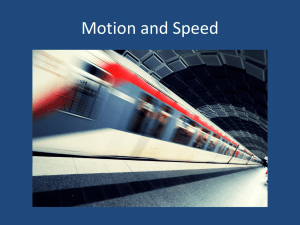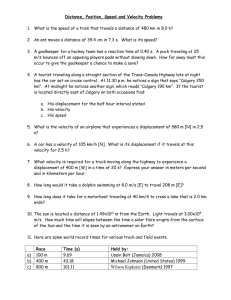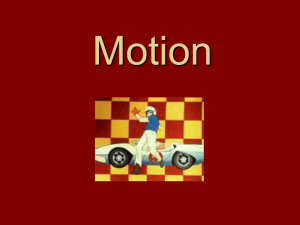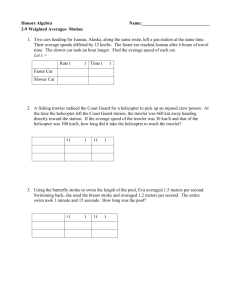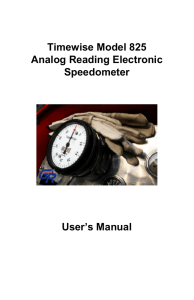Speed and Velocity
advertisement
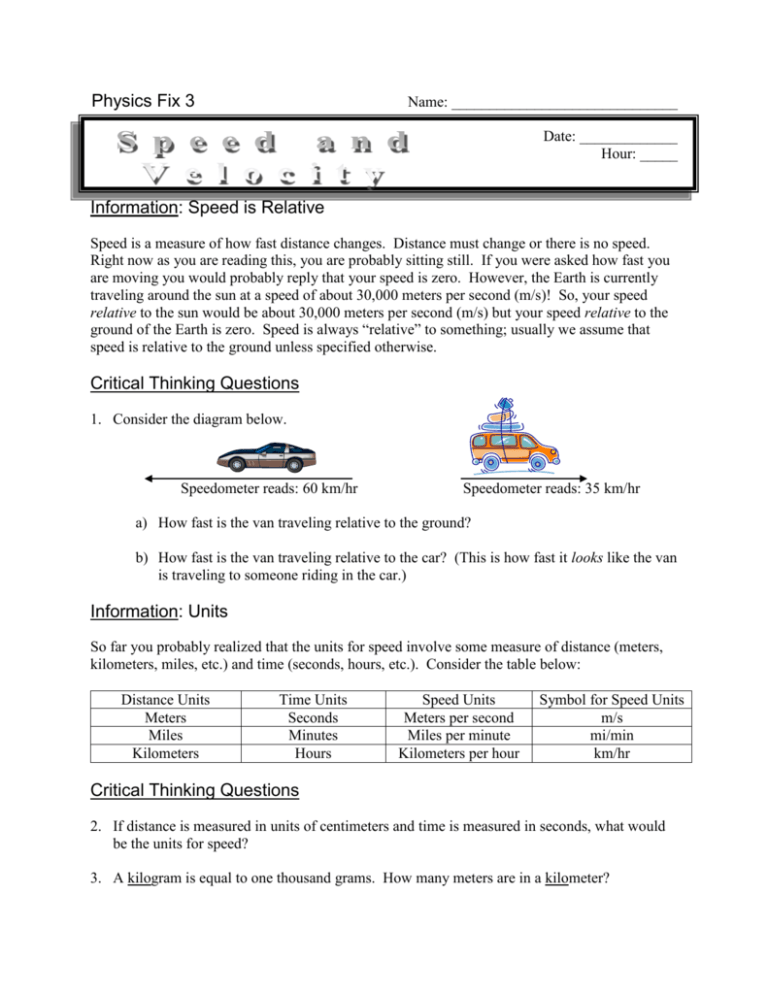
Physics Fix 3 Name: ______________________________ Date: _____________ Hour: _____ Information: Speed is Relative Speed is a measure of how fast distance changes. Distance must change or there is no speed. Right now as you are reading this, you are probably sitting still. If you were asked how fast you are moving you would probably reply that your speed is zero. However, the Earth is currently traveling around the sun at a speed of about 30,000 meters per second (m/s)! So, your speed relative to the sun would be about 30,000 meters per second (m/s) but your speed relative to the ground of the Earth is zero. Speed is always “relative” to something; usually we assume that speed is relative to the ground unless specified otherwise. Critical Thinking Questions 1. Consider the diagram below. Speedometer reads: 60 km/hr Speedometer reads: 35 km/hr a) How fast is the van traveling relative to the ground? b) How fast is the van traveling relative to the car? (This is how fast it looks like the van is traveling to someone riding in the car.) Information: Units So far you probably realized that the units for speed involve some measure of distance (meters, kilometers, miles, etc.) and time (seconds, hours, etc.). Consider the table below: Distance Units Meters Miles Kilometers Time Units Seconds Minutes Hours Speed Units Meters per second Miles per minute Kilometers per hour Symbol for Speed Units m/s mi/min km/hr Critical Thinking Questions 2. If distance is measured in units of centimeters and time is measured in seconds, what would be the units for speed? 3. A kilogram is equal to one thousand grams. How many meters are in a kilometer? 4. To find the correct units for the speed of a car we must… A) Multiply the distance the car travels by the time it takes to travel. B) Add the distance the car travels and the time it takes to travel. C) Divide the distance the car travels by the time it travels. 5. Which one of the following is an equation that you can use to calculate speed. (Note the following symbols: s=speed; d=distance; t=time; =change in) d A) s = d + t B) s C) s = d – t D) s = d t t **Note: the symbol “” is necessary because for an object to have speed, its distance must change as the time ticks (the time is changing too!). 6. Use the correct equation from the previous question to answer the following… a) A car was at a 30 km marker and began to drive as someone else started the stopwatch. The car passed the 90 km marker when the stopwatch read 30.00 minutes. What was the average speed of the car during the time interval? b) A man rowed a boat at a speed of 12 mi/hr. He rowed for 2 hours. How many miles did he travel? 7. Given your answer to question 5 and the fact that units for speed are something like kilometers per hour or meters per second, what does the word “per” signify? A) addition B) subtraction C) division D) multiplying 8. When you are in a car, what is the easiest way to find out how fast you are going in any instant, or moment, of time? (You don’t need a calculator, right?) Information: Average vs. Instantaneous Hopefully, your answer to question 8 involved looking at the speedometer. At any moment (in any instant) you can find your speed by looking at a speedometer. A police officer can find your speed at any instant if he uses his radar gun. The speed on the speedometer or the speed that the police officer finds using a radar gun is called instantaneous speed because it is the speed at an instant or moment of time. In question 6a you calculated the average speed, not the instantaneous speed. Critical Thinking Questions 9. What is the difference between average and instantaneous speed? 10. A snail was traveling across a sidewalk. A brilliant physics student decided to find the snail’s speed and so she found a ruler and a stopwatch. Is the student going to find the snail’s average speed or instantaneous speed? Explain 11. Is it possible to find instantaneous speed by measuring distance and time? Explain. 12. During a certain trip, a car traveled at an average speed of 75 km/hr. Would it be possible to attain such an average speed if the car never had an instantaneous speed of more than 75 km/hr? Explain. Information: Velocity Consider this picture again, but this time notice that both vehicles are traveling at the same speed: Speedometer reads 80 km/hr Speedometer reads 80 km/hr In normal, everyday speech we would use the words “velocity” and “speed” interchangeably to mean the same thing. But in physics, velocity and speed are different from one another. The two vehicles in the picture above have the same speed, but not the same velocity. Weird, eh? Critical Thinking Questions 13. Velocity includes speed AND something else. What do you think makes velocity different from speed? 14. Why do the two vehicles pictured above have different velocities? 15. The following vehicle has the cruise control set to 20 km/hr. The speed is remaining constant, but the velocity is not constant—it is changing. Explain why. 16. What is the average velocity of an airplane that flies… a) … 420 km due north in 1 hour? b) … 210 km due north in ½ hour? c) … 105 km due north in 15 minutes?

